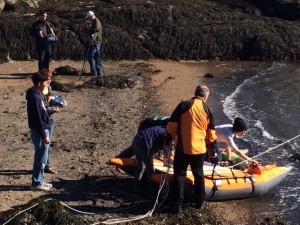After school in Gloucester, Mass., has become geeky cool. Instead of roaming the streets or playing video games, kids who participate in the Applied Robotics Laboratory at Ocean Alliance are learning how to fly drones and analyze whale snot to learn about the environment.
Ocean Alliance, a Gloucester-based charity focusing on ocean research and conservation, received grant funding from the Applied Materials Foundation to expand its high school robotics club and focus on educating youth in how to use robotics to monitor the environment and ecosystems.
Through the club, participating students are challenged to become “environmental ambassadors” through a rigorous curriculum that involves start-to-finish development of underwater and aerial drones. The students are mentored by the scientist through the entire process of building, programming and then flying the drones to collect data over the Atlantic Ocean. This type of mentoring not only encourages interest in STEM careers, but it also creates a new generation of conservationists who will hopefully push environmentally friendly policy forward in the future.
The drone data will be used by scientific partners to advise education and policy makers on wise stewardship of the oceans. The students focus their data collection on the effects of pollution on marine mammal and fish populations. Utilizing data analysis, they explore solutions on how to reduce pollution and its harmful effects, keys in affecting environmental policy.
One program uses a drone called the SnotBot, a small, automated copter that collects samples of whales’ blowhole spray to be analyzed for bacteria, DNA, and hormones. This data is used to monitor whales stress levels and opens to the door for more opportunity to research migration patterns and pollution levels in the ocean. The data will aide in conservation efforts for years to come.
Students in the robotics program are learning not only how to build and fly drones, but they are also being exposed to environmental conservation science, preparing today’s SnotBot operators for a cool, scientific and geeky future.
Students prepare the Snotbot for flight


Leave a Reply